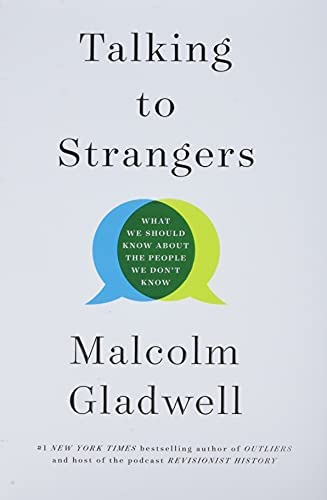Talking to Strangers by Malcolm Gladwell
Reviewed by Michael Attard
The short title, Talking to Strangers, reminds me of what my parents and teachers repeated many times, namely, “Don’t talk to strangers.” It was explained that an unknown person might try to lure a youngster into harm’s way after gaining a child’s trust through simple conversation. Of course, as we mature and progress through life, we meet many strangers, and some of these become our best friends and life partners.
Malcolm Gladwell does not tell us to not talk to strangers, but he strongly advises that for our own sake and the sake of society at large, we should be highly conscious of certain elements of any social discourse with people we do not know, and, for that matter, with individuals we know somewhat.

From my research, it is clear that the book was not well received by critics when it was published in 2019 as Gladwell’s sixth book. There was a feeling that readers would not know where Gladwell was going with his tales of police violence, rape, financial crime, and wrongful murder conviction. But I believe that these diverse and true stories are merely the settings for the points that Gladwell is making. Perhaps, many critics have gotten the story wrong in the same manner as one might interpret an anti-war movie as being a film about Vietnam.
The above thus begs the question, “What is or are Gladwell’s points?” Patience – there are several steps in getting there.
The book’s opening will appeal to those who enjoy a good spy story. The U.S. Central Intelligence Agency, after years of being played, discovers, and only through the defection of a Cuban spy, that their organization was replete with Cuban spies. It is important to note that the CIA had suspected as much but let it go every time. This brings us to what Gladwell refers to as “Puzzle One: Why can’t we tell when the stranger in front of us is lying to our face?”
He elaborates with a study that looked at a list of 550,000 people, all of whom were defendants brought before judges in New York City. There were all sorts of crimes and extenuating circumstances that the judges knew about, and 400,000 of these individuals were released on bail. Next, an artificial intelligence system was given the same information that prosecutors had given to the judges and asked to make a list of the 400,000 people that it would release. The question then becomes, “Whose list committed the fewest crimes while out on bail?” Result: Those on the computer’s list were 25 percent less likely to commit a crime while awaiting trial.
Gladwell refines his thinking with details from European history just before World War Two. This leads to “Puzzle Two: How is it that meeting a stranger face to face can sometimes make us worse at making sense of someone than not meeting them?”
One might think that “Evolution … should have favored people with the ability to pick up on the subtle signs of deception. But it hasn’t.”
This leads to Gladwell’s first major point or conclusion, which is actually drawn from someone else’s work. Namely, that our operating assumption when dealing with people is that they are honest, and this is referred to as the Truth-Default Theory. We believe people because we do not have enough doubts about them. Gladwell contends that this is simply being human.
It would seem then that evolution has left us with a problem. And while Gladwell contends that there can be a trigger point after which we do not believe someone, he also states that the threshold for the trigger is high. For example, a woman may suspect her husband of having an affair for many reasons, but refuses to believe that it is true. Then when she sees a hotel charge on the credit card statement, the trigger is pulled.
Gladwell refers back to the question “Is the Truth-Default Theory a mistake of evolution?” and concludes that it is not. In the story of Bernie Madoff, the financial advisor who stole billions of dollars through his Ponzi scheme, Madoff fooled a lot of people, but there was one person, Harry, who always thought that Madoff was a criminal. However, Harry’s personal story and other studies support the conclusion that if we were all like Harry, “life would be a disaster … suspicion and paranoia would bring society to a standstill.” It seems that meaningful social encounters demand trust.
In part three, Gladwell discusses what he calls “transparency” and defines it as “the idea that people’s behavior and demeanor … provide an authentic and reliable window into the way they feel on the inside.” He recounts the nightmare of Amanda Knox, who was wrongly convicted for the murder of her roommate, largely because her demeanor was all wrong. Prosecutors and others inferred that her not hugging others, the lack of emotion on her face, relaxed poses such as putting her feet on her boyfriend’s lap, and responding loudly and angrily instead of sympathetically as clear signs that she was a murderer. But studies show that people are not transparent. “Surprised people do not necessarily look surprised. People who have emotional problems do not always look like they have emotional problems.” So, while we often work on the premise of “transparency,” Gladwell’s point is that it is a myth, an illusion.
In conclusion then, should we heed the advice that we were given as children to not talk to strangers? No, as that will harm rather than protect us. But as Gladwell advises, we should talk to strangers with caution and humility. Our tendency to trust must be tempered with attention to red flags, and we must remember that things are not always as they seem. Perhaps if we all listen and focus more, we can avoid the pitfalls of not knowing how to talk to one another.
The Reviewer
Michael Attard is a Canadian who has lived in Gwangju since 2004. Though officially retired, he still teaches a few private English classes. He enjoys reading all kinds of books and writes for fun. When the weather is nice, you may find him on a hiking trail.



